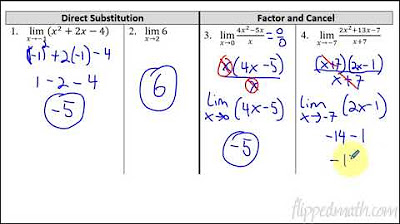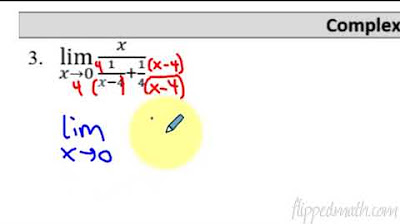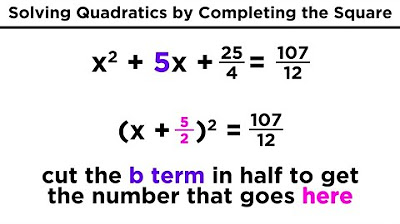Calculus AB/BC – 6.10 Integrating Functions Using Long Division and Completing the Square
TLDRIn this engaging lesson, Mr. Bean tackles advanced algebra 2 topics: completing the square and long division of polynomials. He emphasizes the importance of these techniques in simplifying integrands for integration, especially when direct integration is not feasible. The video offers a step-by-step walkthrough of long division and synthetic division, demonstrating how to handle various polynomial divisions. Mr. Bean also delves into completing the square, showing how it can transform complex expressions into integrable forms. The lesson is a must-watch for those seeking to master these algebraic manipulations and their applications in calculus.
Takeaways
- 📚 The lesson focuses on applying long division and completing the square to manipulate polynomials for integration.
- 🔗 For those unfamiliar with long division or completing the square, additional resources are provided in the video description.
- 🤔 Long division and synthetic division are introduced as methods to simplify polynomials, with synthetic division applicable for linear divisors in the form of x - a.
- 📊 An example of long division is walked through, demonstrating how to divide a cubic polynomial by a linear polynomial.
- 📈 The result of the long division is used to find the antiderivative, showcasing the process of integrating each term.
- 🔄 Synthetic division is shown as a more efficient method for dividing when the divisor is linear, with a step-by-step example provided.
- 🧩 Completing the square is explained as a technique to create perfect squares in quadratic expressions, which simplifies integration.
- 🔢 A detailed example of completing the square is given, transforming a quadratic expression into a form that can be easily integrated.
- 🌐 The concept of u-substitution is introduced for more complex integrals, with an example involving a natural log function.
- 💡 Recognizing when to use long division, completing the square, or u-substitution is emphasized as an important skill for solving difficult integrals.
- 🚀 The lesson concludes with a challenging example modeled after AP exam problems, demonstrating the application of the techniques learned.
Q & A
What is the main topic of the lesson?
-The main topic of the lesson is completing the square and long division polynomial in the context of algebra 2.
Why are completing the square and polynomial long division important in integration?
-Completing the square and polynomial long division are important in integration because they help manipulate the integrand into a form that can be integrated, especially when the integrand is not immediately integrable.
What is the significance of the integrand in the context of this lesson?
-The integrand is significant because it is the part of the integral that we take the anti-derivative of. Manipulating the integrand through completing the square and polynomial long division can make it easier to find the anti-derivative.
What is synthetic division, and when can it be used?
-Synthetic division is a shorthand method for dividing a polynomial by a linear factor of the form x - a. It can be used when the divisor is linear and there is no coefficient in front of the x term.
How does long division work in polynomials?
-Long division in polynomials involves dividing the dividend (the polynomial to be divided) by the divisor (another polynomial), similar to how division works with numbers. You divide the leading term of the dividend by the leading term of the divisor, multiply the divisor by the result, subtract it from the dividend, and bring down the next term to continue the process.
What is the purpose of completing the square in the context of the lesson?
-Completing the square is used to rewrite a quadratic expression in a form that allows for easier integration. It involves adding and subtracting the square of half the coefficient of the linear term to the quadratic expression.
How does the讲师 (lecturer) demonstrate the application of completing the square?
-The lecturer demonstrates the application of completing the square by showing how to rewrite the denominator of an integral in a form where it becomes a perfect square, which can then be integrated using inverse trigonometric functions.
What is the role of u-substitution in integration?
-U-substitution is a technique used in integration to simplify the integrand by replacing a part of it with a new variable, u. This can make the integral easier to solve, especially when dealing with complex fractions or expressions involving inverse trigonometric functions.
What is the significance of recognizing patterns in integration?
-Recognizing patterns in integration is crucial because it helps determine the appropriate method to use for solving a given integral. It can make the process more efficient and less prone to errors.
How does the讲师 (lecturer) address the challenge of recognizing when to use certain techniques in integration?
-The lecturer acknowledges that recognizing when to use certain techniques like completing the square or u-substitution is a key skill that students need to develop. The lecturer plans to discuss this in the last lesson of the unit, focusing on pattern recognition.
What is the final challenging problem presented in the lesson?
-The final challenging problem involves a complex integral with a denominator that requires completing the square and u-substitution to simplify and solve. The lecturer walks through the process of transforming the integrand into a form that can be integrated using the tangent inverse function.
Outlines
📚 Introduction to Completing the Square and Long Division
This paragraph introduces the topic of completing the square and long division in the context of algebra 2. Mr. Bean explains that the lesson will not teach these methods from scratch but may remind those who already know them. He emphasizes the importance of these techniques in manipulating the integrand for integration, particularly when the integrand cannot be directly integrated. Mr. Bean also mentions that resources will be provided for those who need to learn these methods from the beginning.
📝 Long Division and Synthetic Division Examples
In this paragraph, Mr. Bean walks through the process of long division, using an example to illustrate how to divide a polynomial. He then explains synthetic division, a shortcut method for dividing when the divisor is linear. The paragraph includes a step-by-step demonstration of both methods, highlighting when to use each one and how they can simplify the process of finding the integral of a polynomial.
🔢 Advanced Techniques: U-Substitution and Completing the Square
This paragraph delves into more advanced mathematical techniques, including u-substitution and completing the square. Mr. Bean provides a detailed explanation of how to apply these methods to complex integrals, transforming them into more manageable forms. The paragraph includes a challenging example that requires both long division and u-substitution, demonstrating the process of solving complex problems in calculus.
🧠 Mastering the Concepts: AP Exam-Style Problems
The final paragraph focuses on preparing for the AP exam by tackling a problem similar to those found on the exam. Mr. Bean guides the audience through the process of completing the square and using u-substitution to solve a difficult integral. He emphasizes the importance of recognizing when to apply these techniques and encourages practice to master the concepts for the AP exam.
Mindmap
Keywords
💡Completing the Square
💡Polynomial Long Division
💡Integrand
💡Synthetic Division
💡Anti-derivative
💡U-Substitution
💡Coefficient
💡Placeholder
💡Inverse Trig Functions
💡Natural Logarithm
Highlights
Introduction to the lesson on completing the square and long division polynomial in algebra 2.
Clarification that the lesson assumes prior knowledge of the topics and provides resources for those unfamiliar.
Explanation of the importance of completing the square and long division in relation to the integrand in calculus.
Demonstration of long division with a polynomial, including the step-by-step process.
Use of synthetic division for simpler problems with a linear divisor.
Example of how to take the anti-derivative after performing long division.
Reiteration of the lesson's purpose and the application of long division and completing the square in calculus.
Detailed walkthrough of a complex integral problem using long division and u-substitution.
Introduction to completing the square with a focus on the quadratic term and linear term.
Illustration of completing the square with a negative coefficient in front of x squared.
Example of completing the square with a radical in the denominator.
Explanation of how to handle a complex integral with both long division and completing the square.
Demonstration of recognizing when to use completing the square during problem-solving.
Presentation of a challenging problem similar to those found on AP exams.
Solution to the challenging problem using completing the square and u-substitution.
Conclusion of the lesson with encouragement for further practice and mastery.
Transcripts
Browse More Related Video

Calculus AB/BC – 1.6 Determining Limits Using Algebraic Manipulation

Calculus AB/BC – 1.7 Selecting Procedures for Determining Limits

Integral of a Quotient

Factoring Polynomials - By GCF, AC Method, Grouping, Substitution, Sum & Difference of Cubes

Polynomials - Long Division

Solving Quadratics by Completing the Square
5.0 / 5 (0 votes)
Thanks for rating: